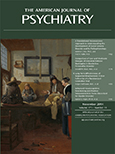Response to Granoff
To the Editor: Dr. Granoff comments on the benzodiazepine arm of our study in which Afghanistan and Iraq veterans with posttraumatic stress disorder (PTSD) received six sessions total, with five sessions of virtual reality exposure therapy combined with 0.25 mg of alprazolam or 50 mg of d-cycloserine or pill placebo administered 30 minutes prior to the virtual reality sessions. We agree with Dr. Granoff’s first comment that the dose of alprazolam at 0.25 mg is generally subtherapeutic. However, we would point out that this can be an effective dose for some people with anxiety, so it is not entirely a subclinical dose. With that said, we did purposefully choose a low dose of alprazolam in an attempt to not break the blind. d-Cycloserine is virtually undetectable when administered as used in our study (i.e., 50 mg once/week), and it was felt that even 0.50 mg of alprazolam may be noticeable by the subject and thus break the blind. Dr. Granoff’s second point, that “having participants discontinue their short-acting benzodiazepines 2 weeks before screening and discontinue their long-acting benzodiazepines 1 month before screening followed by a subtherapeutic dose of alprazolam is likely to have contributed to the lack of treatment effects in the alprazolam group,” likely had less of an impact. This is because very few subjects in the study discontinued chronic benzodiazepine use, so we do not believe that this possibility explains our data. This also addresses Dr. Granoff’s third point, that the number of patients who discontinued benzodiazepines was not reported. The fact that such a low dose of alprazolam was associated with lower efficacy of virtual reality exposure therapy we feel makes an even stronger case that benzodiazepines should be used with caution in general with patients with PTSD and certainly when patients are receiving exposure therapy. In conclusion, we agree that benzodiazepines in general can be quite useful for treatment of anxiety disorders. However, there is also the possibility, specifically with regard to extinction-based prolonged exposure therapy, that benzodiazepines may in some cases interfere with the consolidation of emotional memory during this process, as suggested in our study, and that this possibility warrants further investigation.



